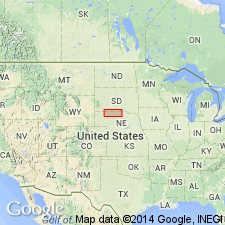
- Usage in publication:
-
- Cornell Dam Member
- Modifications:
-
- Original reference
- Dominant lithology:
-
- Sandstone
- AAPG geologic province:
-
- Chadron arch
- Salina basin
Summary:
Pg. 230 (fig. 3), 246 (fig. 4), 250-251 (fig. 5), 252-253, 256-268. Cornell Dam Member of Valentine Formation of Ogallala Group. Recognized in central northern Nebraska. Consists of gray, whitish-weathering, firm, silty sandstone and clay containing manganese stained nodules and glass shards. Includes [informal] Hurlbut ash near top (age recalculated to 11.6 +/-1.1 Ma by Boellstorff, see p. 252). Thickness 0 to 162 feet; 42 feet at type section. Unconformably overlies Rosebud Formation of Arikaree Group; unconformably underlies Crookston Bridge Member of Valentine. Fossils. Includes vertebrate Norden fauna, and Norden Bridge and Egelhoff local faunas. Age is middle Miocene (Valentinian NALMA; Barstovian NALMA of some paleontologists). [On p. 252, authors state Valentinian is applied to faunas that occur in the Valentine Formation and the Valentinian represents a period of possibly 3 m.y. duration. Some paleontologists place the Valentine Formation in the middle Barstovian to early Clarendonian NALMA.]
Type section: roadcut a few mi northeast of town of Valentine on west side of NE State Highway 12, west of original mouth of Minnechaduza Creek and its junction with Niobrara River, in SE/4 sec. 22, T. 34 N., R. 27 W., Lat. 42 deg. 53 min. 50 sec. N., Long. 100 deg. 29 min. 05 sec. W., [Cornell Dam 7.5-min quadrangle], Cherry Co., central northern NE. Named from Cornell Dam on Niobrara River, 0.25 mi above mouth of Minnechaduza Creek.
Reference sections: (1) on north side of Niobrara River at Rock Rapids [Rocky Ford], in secs. 9 and 16, T. 33 N., R. 24 W., [Muleshoe Creek 7.5-min quadrangle], Keya Paha Co., central northern NE; (2) on south side of Niobrara River at Norden Bridge, in SW/4 NE/4 SW/4 sec. 33, T. 33 N., R. 23 W., [Norden 7.5-min quadrangle], Brown Co., central northern NE.
Source: Publication; US geologic names lexicon (USGS Bull. 1565, p. 75-76).
For more information, please contact Nancy Stamm, Geologic Names Committee Secretary.
Asterisk (*) indicates published by U.S. Geological Survey authors.
"No current usage" (†) implies that a name has been abandoned or has fallen into disuse. Former usage and, if known, replacement name given in parentheses ( ).
Slash (/) indicates name conflicts with nomenclatural guidelines (CSN, 1933; ACSN, 1961, 1970; NACSN, 1983, 2005, 2021). May be explained within brackets ([ ]).

